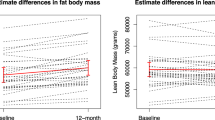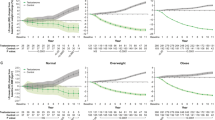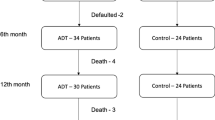Abstract
Background
Unlike in other mouse models of atherogenesis, it has recently been suggested that orchiectomy plays a role in attenuating atherosclerosis and inhibiting the progression of cardiovascular disease in the ApoE−/−:Ins2+/Akita mouse model of hyperglycemia. Androgen-deprivation therapy (ADT) is a common treatment for prostate cancer, a population with high prevalence of cardiovascular disease and its risk factors. Our objectives were to test and further characterize the effects of pharmacological castration which is currently the acceptable modality to deliver ADT in the clinic.
Methods
Male ApoE−/−:Ins2+/Akita mice received one of three modes of ADT (gonadotropin-releasing hormone (GnRH)-antagonist (degarelix), GnRH-agonist (leuprolide), or bilateral orchiectomy) and were compared to corresponding untreated control mice (n = 9–13/group). Mice were followed for 5 months. Body weight, fasting blood glucose, glucose tolerance, serum C-peptide, leptin, and testosterone levels along with atherosclerotic aortic plaque size and characteristics were determined. In a separate experiment, the survival of mice, untreated and on ADT, was determined.
Results
Castration was achieved for all three modes of ADT. However, degarelix-treated mice gained significantly less weight, had lower serum leptin levels and systolic blood pressure compared to orchiectomy and leuprolide-treated mice. ADT improved dysglycemia and atherosclerotic burden. GnRH-antagonist significantly improved survival compared to GnRH-agonist but not compared to orchiectomy.
Conclusions
Further characterization of the ApoE−/−:Ins2+/Akita mouse model confirms that pharmacological ADT ameliorated metabolic syndrome and cardiovascular complications. Improved dysglycemia and atherosclerosis associated with increased survival which was longest after degarelix followed by orchiectomy.
This is a preview of subscription content, access via your institution
Access options
Subscribe to this journal
Receive 4 print issues and online access
$259.00 per year
only $64.75 per issue
Buy this article
- Purchase on Springer Link
- Instant access to full article PDF
Prices may be subject to local taxes which are calculated during checkout





Similar content being viewed by others
Change history
19 August 2021
A Correction to this paper has been published: https://doi.org/10.1038/s41391-021-00408-2
References
Satariano WA, Ragland KE, Van Den Eeden SK. Cause of death in men diagnosed with prostate carcinoma. Cancer. 1998;83:1180–8.
Lu-Yao G, Stukel TA, Yao SL. Changing patterns in competing causes of death in men with prostate cancer: a population based study. J Urol. 2004;171:2285–90.
Shahinian VB, Kuo YF, Gilbert SM. Reimbursement policy and androgen-deprivation therapy for prostate cancer. N Engl J Med. 2010;363:1822–32.
Keating NL, O’Malley AJ, Smith MR. Diabetes and cardiovascular disease during androgen deprivation therapy for prostate cancer. J Clin Oncol. 2006;24:4448–56.
Tsai HK, D’Amico AV, Sadetsky N, Chen MH, Carroll PR. Androgen deprivation therapy for localized prostate cancer and the risk of cardiovascular mortality. J Natl Cancer Inst. 2007;99:1516–24.
Saigal CS, Gore JL, Krupski TL, Hanley J, Schonlau M, Litwin MS. Androgen deprivation therapy increases cardiovascular morbidity in men with prostate cancer. Cancer. 2007;110:1493–1500.
Van Hemelrijck M, Garmo H, Holmberg L, Ingelsson E, Bratt O, Bill-Axelson A, et al. Absolute and relative risk of cardiovascular disease in men with prostate cancer: results from the population-based PCBaSe Sweden. J Clin Oncol. 2010;28:3448–56.
Keating NL, O’Malley AJ, Freedland SJ, Smith MR. Diabetes and cardiovascular disease during androgen deprivation therapy: observational study of veterans with prostate cancer. J Natl Cancer Inst. 2010;102:39–46.
Crook JM, O’Callaghan CJ, Duncan G, Dearnaley DP, Higano CS, Horwitz EM, et al. Intermittent androgen suppression for rising PSA level after radiotherapy. N. Engl J Med. 2012;367:895–903.
Albertsen PC, Klotz L, Tombal B, Grady J, Olesen TK, Nilsson J. Cardiovascular morbidity associated with gonadotropin releasing hormone agonists and an antagonist. Eur Urol. 2014;65:565–73.
Margel D, Peer A, Ber Y, Shavit-Grievink L, Tabachnik T, Sela S, et al. Cardiovascular morbidity in a randomized trial comparing GnRH agonist and GnRH antagonist among patients with advanced prostate Cancer and preexisting cardiovascular disease. J Urol. 2019;202:1199–1208.
Hopmans SN, Duivenvoorden WCM, Werstuck GH, Pinthus J. GnRH antagonists associate with less weight gain and milder characteristics of the metabolic syndrome compared to orchiectomy and GnRH agonists in a preclinical mouse model. Urol Oncol. 2014;32:1126–34.
Knutsson A, Hsiung S, Celik S, Rattik S, Mattisson IY, Wigren M, et al. Treatment with a GnRH receptor agonist, but not the GnRH receptor antagonist degarelix, induces atherosclerotic plaque instability in ApoE(-/-) mice. Sci Rep. 2016;6:26220.
FDA Drug Safety Communication: Update to Ongoing Safety Review of GnRH Agonists and Notification to Manufacturers of GnRH Agonists to Add New Safety Information to Labeling Regarding Increased Risk of Diabetes and Certain Cardiovascular Diseases. 2010; https://www.fda.gov/drugs/drug-safety-and-availability/fda-drug-safety-communication-update-ongoing-safety-review-gnrh-agonists-and-notification. Accessed 12 April 2020.
Yannucci J, Manola J, Garnick MB, Bhat G, Bubley GJ. The effect of androgen deprivation therapy on fasting serum lipid and glucose parameters. J Urol. 2006;176:520–5.
Braga-Basaria M, Dobs AS, Muller DC, Carducci MA, John M, Egan J, et al. Metabolic syndrome in men with prostate cancer undergoing long-term androgen-deprivation therapy. J Clin Oncol. 2006;24:3979–83.
Haseen F, Murray LJ, Cardwell CR, O’Sullivan JM, Cantwell MM. The effect of androgen deprivation therapy on body composition in men with prostate cancer: systematic review and meta-analysis. J Cancer Surviv. 2010;4:128–39.
Smith MR, Finkelstein JS, McGovern FJ, Zietman AL, Fallon MA, Schoenfeld DA, et al. Changes in body composition during androgen deprivation therapy for prostate cancer. J Clin Endocrinol Metab. 2002;87:599–603.
van Londen GJ, Levy ME, Perera S, Nelson JB, Greenspan SL. Body composition changes during androgen deprivation therapy for prostate cancer: a 2-year prospective study. Crit Rev Oncol Hematol. 2008;68:172–7.
Biolo G, Ciocchi B, Stulle M, Piccoli A, Lorenzon S, Dal Mas V, et al. Metabolic consequences of physical inactivity. J Ren Nutr. 2005;15:49–53.
Corcoran MP, Lamon-Fava S, Fielding RA. Skeletal muscle lipid deposition and insulin resistance: effect of dietary fatty acids and exercise. Am J Clin Nutr. 2007;85:662–77.
Smith MR, Lee H, Nathan DM. Insulin sensitivity during combined androgen blockade for prostate cancer. J Clin Endocrinol Metab. 2006;91:1305–8.
Gami AS, Witt BJ, Howard DE, Erwin PJ, Gami LA, Somers VK, et al. Metabolic syndrome and risk of incident cardiovascular events and death: a systematic review and meta-analysis of longitudinal studies. J Am Coll Cardiol. 2007;49:403–14.
Leong DP, Fradet V, Shayegan B, Duceppe E, Siemens R, Niazi T, et al. Cardiovascular risk in men with prostate cancer: insights from the RADICAL PC study. J Urol. 2020;203:1109–16.
Wang J, Takeuchi T, Tanaka S, Kubo SK, Kayo T, Lu D, et al. A mutation in the insulin 2 gene induces diabetes with severe pancreatic beta-cell dysfunction in the Mody mouse. J Clin Invest. 1999;103:27–37.
Venegas-Pino DE, Wang PW, Stoute HK, Singh-Pickersgill NA, Hong BY, Khan MI, et al. Sex-specific differences in an ApoE(-/-):Ins2(+/Akita) mouse model of accelerated atherosclerosis. Am J Pathol. 2016;186:67–77.
Poulsen CB, Mortensen MB, Koechling W, Sorensen CB, Bentzon JF. Differences in hypercholesterolemia and atherogenesis induced by common androgen deprivation therapies in male mice. J Am Heart Assoc. 2016;5:e002800.
Van Poppel H, Tombal B. Cardiovascular risk during hormonal treatment in patients with prostate cancer. Cancer Manag Res. 2011;3:49–55.
Wu L, Vikramadithyan R, Yu S, Pau C, Hu Y, Goldberg IJ, et al. Addition of dietary fat to cholesterol in the diets of LDL receptor knockout mice: effects on plasma insulin, lipoproteins, and atherosclerosis. J Lipid Res. 2006;47:2215–22.
Ishibashi S, Goldstein JL, Brown MS, Herz J, Burns DK. Massive xanthomatosis and atherosclerosis in cholesterol-fed low density lipoprotein receptor-negative mice. J Clin Invest. 1994;93:1885–93.
Plump AS, Smith JD, Hayek T, Aalto-Setala K, Walsh A, Verstuyft JG, et al. Severe hypercholesterolemia and atherosclerosis in apolipoprotein E-deficient mice created by homologous recombination in ES cells. Cell. 1992;71:343–53.
Zhang SH, Reddick RL, Piedrahita JA, Maeda N. Spontaneous hypercholesterolemia and arterial lesions in mice lacking apolipoprotein E. Science. 1992;258:468–71.
Gao J, Katagiri H, Ishigaki Y, Yamada T, Ogihara T, Imai J, et al. Involvement of apolipoprotein E in excess fat accumulation and insulin resistance. Diabetes. 2007;56:24–33.
Jun JY, Ma Z, Segar L. Spontaneously diabetic Ins2(+/Akita):apoE-deficient mice exhibit exaggerated hypercholesterolemia and atherosclerosis. Am J Physiol Endocrinol Metab. 2011;301:E145–54.
Klotz L, Boccon-Gibod L, Shore ND, Andreou C, Persson BE, Cantor P, et al. The efficacy and safety of degarelix: a 12-month, comparative, randomized, open-label, parallel-group phase III study in patients with prostate cancer. BJU Int. 2008;102:1531–8.
Venegas-Pino DE, Lagrotteria A, Wang PW, Morphet J, Clapdorp C, Shi Y, et al. Evidence of extensive atherosclerosis, coronary artery disease and myocardial infarction in the ApoE(-/-):Ins2(+/Akita) mouse fed a western diet. Atherosclerosis. 2018;275:88–96.
Acknowledgements
Financial support provided by the CUA-CUOG Astellas Research Grant Program funded by Astellas Pharma Canada, Inc. (jointly established by Astellas Pharma Canada, Inc., Canadian Urological Association and the Canadian Urological Oncology Group) (to SD), McMaster Surgical Associates grant, Ferring Pharmaceuticals through an investigator-initiated grant to JHP. Ferring Pharmaceuticals had no involvement in study design, collection, analysis, and interpretation of data, writing of the report or the decision to submit for publication.
Author information
Authors and Affiliations
Corresponding author
Ethics declarations
Conflict of interest
JHP has acted in a consulting role for Ferring Pharmaceuticals; has received research funding for projects from Ferring Pharmaceuticals. The remaining authors have no conflict of interest.
Additional information
Publisher’s note Springer Nature remains neutral with regard to jurisdictional claims in published maps and institutional affiliations.
The original online version of this article was revised: The original version of this article unfortunately contained a mistake in the first sentence of the Background section of the Abstract.
Supplementary information
Rights and permissions
About this article
Cite this article
Duivenvoorden, W.C.M., Naeim, M., Hopmans, S.N. et al. Protective effect of pharmacological castration on metabolic perturbations and cardiovascular disease in the hyperglycemic male ApoE−/−:Ins2+/Akita mouse model. Prostate Cancer Prostatic Dis 24, 389–397 (2021). https://doi.org/10.1038/s41391-020-00288-y
Received:
Revised:
Accepted:
Published:
Issue Date:
DOI: https://doi.org/10.1038/s41391-020-00288-y



